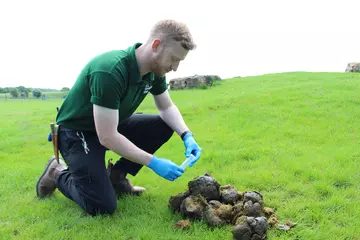Zookeepers at Whipsnade Zoo are collecting elephant dung samples to help conservationists across Asia and Africa better understand the population sizes, movements and ‘genetic fingerprints’ of wild elephant herds.
How are elephant dung samples used?
Whipsnade Zoo’s elephant keepers began the research into dung sampling after their ZSL colleagues working with wild elephant populations in Africa and Asia alerted them to a specific knowledge gap within the scientific community.
Conservationists regularly use faecal DNA testing on collected samples of wild elephant dung to assess population size, identify priority populations, select elephants suitable for translocations, and identify inbreeding. However, there is still uncertainty about how long samples can be stored before analysis in the laboratory, or which method is best for preserving the samples.
How did the Whipsnade team collect the dung samples?
For the study, elephant keepers collect small amounts of dung from Whipsnade Zoo’s herd of Asian elephants, of varying freshness (for example, <24 hrs old, 24-48 hrs old, >48 hrs old), and place them in a test tube, ensuring no cross-contamination takes place. They then store the samples using different methods and preservatives (or ‘buffer solutions’) for various lengths of time before genotyping of, or ‘retrieving a genetic fingerprint from’, the samples takes place in a laboratory. The ZSL keepers and conservation scientists will then analyse the results and share their conclusions with elephant conservationists around the world.
Whipsnade Zoo’s Elephant Team Leader, Stefan Groeneveld said: “We are always finding new ways in which our understanding of our magnificent herd of elephants at Whipsnade Zoo can benefit their wild counterparts.
“I’m sure running around after elephants to collect and record their dung throughout the day doesn’t sound like everyone’s idea of fun, but we are delighted to be able to use the resources we have to give our colleagues across Asia and Africa the information they need to prevent elephant extinction.

“We spend every day with our herd, and know each of them not only by name, but by character. This is the sort of research that just couldn’t be done in the wild, where you can’t necessarily know how old a dung-pile is, or have a ready supply of fresh dung from known individuals to experiment with. With so much information at our fingertips, we hope that our contribution to the study of elephant faecal DNA analysis will be invaluable for global conservation efforts.”
Faecal DNA methods are used with all three elephant species living in the wild: African savannah elephants, African forest elephants, and Asian elephants. They are especially useful to assess elephant herds living in dense forests, where aerial surveys are not possible. ZSL conservationists are currently working to protect and conserve elephant populations in Thailand, Nepal, India and Cameroon. Elephant populations are under threat from the illegal wildlife trade, human-elephant conflict, habitat loss, habitat fragmentation and degradation, and disease.
The UK’s largest Zoo, Whipsnade Zoo has been dedicated to the conservation of threatened species since its opening, 90 years ago. Best known for its colossal beasts that graze enormous enclosures, like the Zoo’s herd of endangered Asian elephants or its two species of rhinoceroses, Whipsnade Zoo is home to over 10,000 amazing animals, including Amur tigers, reticulated giraffes and African wild dogs. Proudly helping to protect Globally Threatened species, Whipsnade has contributed to reintroductions of Extinct-in-the-Wild species, such as the Przewalski’s horse and the scimitar horned oryx and boasts the UK’s first aquarium dedicated to conserving threatened and Extinct-in-the-Wild freshwater fish.
